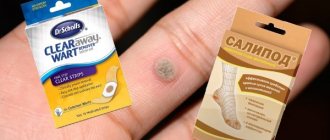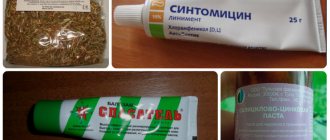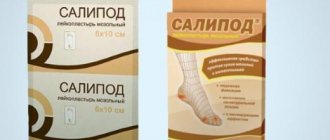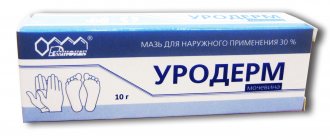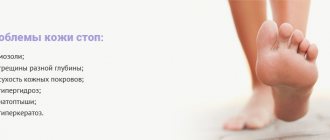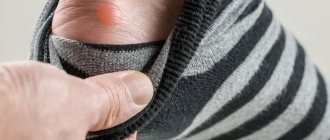Very often, after purchasing shoes, in the first days unpleasant formations appear on the skin, which are accompanied by painful symptoms and bring a lot of trouble. It is for such cases that a special Compeed callus patch has been developed. The patch is very convenient and allows you to quickly and efficiently fix the problem.
Calluses come in many varieties and are small areas of dead skin with or without fluid inside. Such formations appear after friction of the skin covering with a shoe, and as a result of such exposure, the process of inflammation begins.
Most often such formations appear on the back of the foot or on the toes. Therefore, to eliminate this type of formation, various types of bactericidal patches are very often used.
Types of Compeed patches
There are many varieties of patches manufactured by Johnson & Johnson.
These include:
- Compeed for corns and calluses - has a special type of filling that affects the epidermis, produces a softening effect, due to which the healing properties of the patch penetrate deep into the layers of the epidermis and relieve the inflammatory process;
- Compeed to eliminate dry calluses – the components of the patch soften and eliminate rough skin;
- Compeed from blisters and wet formations - special components and a breathable structure allow you to absorb liquid and eliminate the possibility of bacteria entering the damaged area;
- Compeed for ingrown calluses - nourishes and softens the rough skin surface, making it possible to quickly eliminate the defect.
Compeed for corns and calluses
Compeed to eliminate dry calluses
Compeed against blisters and wet spots
Compeed for ingrown calluses
Compeed pencil is also available It is used to prevent the occurrence of calluses. When used, it forms a kind of protective film and softens the impact of shoes on the skin.
Each type of patch has instructions for use and is recommended to be used only for its intended purpose.
Purpose
Each package of hygiene products is supplied with instructions for use. It indicates what type of callus the product is intended for. Compid effectively eliminates destructive formations of various etiologies and localizations.
Indications for use:
- keratinized layers;
- deeply ingrown calluses;
- abrasions between the toes, on the heel, on the foot;
- epidermal cracks;
- exudate-filled and inflamed areas of the skin;
- growths;
- bacterial and fungal infections.
The Compid line of hydrocolloid products prevents dust particles, dirt, and any foreign elements from entering open wounds. The patch protects damaged areas of the epidermis from mechanical pressure, temperature and chemical influences.
How to choose the right patch?
When choosing a patch, it is necessary to proceed from the type of callus, and you should also take into account the location of the formations, since the patches have different shapes and sizes.
Particular attention should be paid to formations that appear between the fingers, since the usual size of the patch is not suitable for use, so it is necessary to purchase Compeed, which has a special shape and purpose.
The correct size will prevent the patch from moving to the side and reduce the risk of further damage to the skin.
Indications for use
According to the instructions for use, the Compid patch is intended for healing calluses.
A callus is a keratinized area of the skin that consists of dead cells. Calluses form as a result of prolonged pressure or friction of the skin.
There are several types of calluses:
Damp or wet is a bubble of a thin layer of skin filled with liquid. Such calluses appear on the feet and hands in the area of the fingers. They occur very quickly and take a long time to heal. When a blister ruptures, inflammation may develop;
- Dry - a small solid formation;
- Ingrown is a growth that has a rod. The formation of an ingrown callus occurs on rough areas of the skin. It has a round shape, with a small depression in the center;
- A corn is a growth that forms on the foot. It can cause severe pain and discomfort when moving. If left untreated, calluses can cause the development of flat feet.
The principle of action on corns
The principle of operation of the patch is to perform the following tasks:
- Relief of painful sensations;
- Reducing the appearance of cracks and other damage at the site of corn formation;
- Reduces the likelihood of bacteria entering the inflammation site;
- Has a softening effect and moisturizes the epidermis;
- The special base of the patch allows the skin to breathe.
Thanks to its convenient shape, the patch is easy to apply and does not come off when moving.
The product has a waterproof surface, so if necessary, a person can carry out water procedures without removing the antibacterial agent.
Classification of calluses
A dry callus is a limited area of yellowish, keratinized, thickened, dense skin.
Painful when located at the base of the fingers on the plantar or palmar surface.
Calluses on the heels lead to the formation of cracks, which can become painful and become infected.
Causes of dry calluses:
- work in a standing position
- long walk
- tight and narrow shoes
- working with tools (construction, musical, sports, power tools)
- dry skin where calluses form
- thinning of subcutaneous fat in areas where calluses form
A soft callus—otherwise known as a wet callus—is saturated with moisture and softens, forming blisters.
Microtraumas cause inflammation with damage to the deep layers of the skin.
Under the pressure of the released interstitial fluid, the surface epidermis rises.
Moisture sweats inside and bubbles form.
A typical place for the formation of such calluses is the interdigital folds.
Such calluses cause extreme pain and are dangerous when the bladder is opened due to the risk of infection.
Causes of soft calluses:
- microtraumas and cracks
- wet skin where calluses form
- thinning of the skin and subcutaneous fat
- tight shoes or tight wet gloves
- wet socks or stockings
- increased sweating of the feet
- thinning of the skin and infection
A core (or “ingrown”) callus is a dense, round area of hyperkeratosis.
With clear boundaries and a hard transparent whitish rod in the center, when viewed it resembles a lid.
They are formed in response to injury by a foreign body (stone, splinter) in places where bone bases press on soft tissue.
The rod consists of a stratum corneum, as hard as a nail plate.
Therefore, when vertical pressure is applied to the callus, severe pain is felt due to compression of the dermal nerves.
Callus must be distinguished from plantar warts, since the treatment indicated is different.
A plantar wart is similar in appearance to a callus, but its surface looks loose, with brown dots.
And pain appears with any pressure, including from the sides.
There is usually only one core callus, and small, daughter similar formations form next to the large wart.
Causes of callus formation:
- high heels shoes
- work in a standing position
- untreated soft callus
- viral and fungal infections
- microtrauma of the skin
- constant pressure or rubbing of a specific area of skin
- diabetes
- flat feet
Subungual keratosis, in which the nail folds appear as thickenings on the side of the nail plate in the form of a dense yellow-gray mass.
The nail becomes dense, dull, deformed, and partially destroyed on both sides.
Such formation may indicate a fungal infection of the nail.
Therefore, you should see a mycologist, as well as the development of panaritium or an ingrown nail.
Reasons for the formation of subungual keratosis:
- failure to comply with hygiene rules
- diabetes mellitus (diabetic foot)
- violation of the trophism of the skin of the feet
- nail phalanx injuries
Corns are areas of hardened skin on the plantar surface of the foot.
Causes of corns formation:
- tight shoes with insufficiently rigid and thin soles (calluses in the heel area)
- high heels (corns in the big toe area)
- displacement of the center of gravity with valgus or varus position of the feet (corns on the lateral surface of the foot)
- Reduced spring function of the foot due to flat feet (calluses all over the sole)
Children more often develop soft (“wet”, “weeping”) calluses that look like a bubble with liquid.
Reasons for the formation of a soft callus with a blister in children:
- Tight shoes
- Shoes with rough seams, made of leatherette
- Shoes that are too big (not the right size)
- Large socks or tights that bunch up when wearing shoes
In women, soft (“wet”) calluses are more common on the upper extremities when working in their summer cottage or in places where they are compressed by tight shoes.
Often, core and dry types of calluses appear as a result of constant pressure or friction.
For example, when working with sports (stick, dumbbells, barbells, clubs) or athletic (mechanical and electrical simulators) equipment.
Or when constantly carrying heavy loads.
Dry calluses are common among musicians, in particular on the fingers of a guitarist or calluses on the fingers and chin of a violinist.
Older people can develop all types of calluses.
Age-related dry skin stimulates the formation of dry calluses and corns.
Thinning of the skin leads to cracks and the formation of wet calluses; ingrown toenails are formed due to poor foot hygiene against the background of subungual keratosis.
Painful sensations and impaired sensitivity of the feet lead to the risk of falls in an elderly person, or even refusal to walk.
With a long course of the disease, bedsores may appear on the feet.
Advantages of the Compeed patch
The following types of advantages in using the Compeed patch should be highlighted:
- The patches are designed to treat inflammatory lesions, not to mask them;
- The drug is practically invisible on the skin, and is used even when using open-type shoes;
- The thickness of the patch allows you not to leave the product on the skin;
- Special components of the drug nourish and moisturize the damaged area of the skin;
- Reduction of painful symptoms in a short time;
- Reduces the intensity of the mechanical impact of shoes on the skin;
- The patch protects the source of inflammation from moisture and various types of bacteria;
- Designed for long-term use, even during water treatments;
- Available in various sizes and shapes designed for use in the area between the fingers;
- Easy to use;
- Reduces the risk of scar formation in areas of skin damage;
- It is elastic and easily takes the shape of the surface on which it is glued;
- Does not require the application of additional medications for the antibacterial effect;
- For each type of problem there is a specific type of patch;
- Convenient packaging allows you to always carry the drug with you and use it at any time necessary.
Action of the product
The main effect of the Compid adhesive plaster is aimed at reducing pain when moving. Using a patch allows you to moisturize rough areas of the skin, which significantly speeds up healing. The product softens the tissue of dry calluses and corns.
When applied to wet injuries, the adhesive plaster quickly eliminates pain and also prevents infection.
The main advantages of the Compeed callus patch are:
analgesic effect under pressure and friction due to the use of materials of special strength and optimal width of the product for the manufacture;
- hygroscopicity;
- healing of calluses within a short time due to the creation of special conditions;
- antiseptic properties that provide protection against the penetration of pathogenic microorganisms;
- high breathability;
- promotes rapid removal of dry calluses;
- easy to use;
- wide choice of sizes and shapes of the product.
Among the disadvantages, they note the impossibility of using it in places of wounds and abrasions, since this will cause the development of inflammation, burning and will only increase discomfort.
Mode of application
For proper use, it is recommended to carefully read the instructions that come with the drug; the further result of the treatment will depend on how correctly the product is selected and used according to the instructions.
For wet calluses
The drug has a special structure that has bactericidal properties and prevents the formation of dryness at the site of injury.
It is recommended to use the patch as follows:
- Wash the surface of the epidermis with antibacterial soap;
- Remove all crusts from the skin and dry the skin;
- Remove the protective film from the patch and apply tightly to the damaged area;
- Do not remove the patch throughout the day.
It is recommended to use immediately after damage to the skin occurs.
If a small formation with liquid inside appears on the surface of the patch, this indicates complete absorption of the contents of the callus.
To prevent damage to the blister, you should stick the patch carefully and the first time, since when you stick it again, the sticky surface loses its quality and can come off after a short period of time.
Plasters for core calluses
For core calluses, the choice is usually the Salipod patch.
It contains salicylic acid, precipitated sulfur, lanolin and natural rubber.
A fragment is manually cut out of the patch, the shape and diameter corresponding to the callus core.
It is applied to it and secured on top with an adhesive plaster for 48 hours.
If there is no effect, Salipod is reused.
This patch is very effective, but has a number of contraindications.
These are pregnancy, early childhood, allergic reactions, open wounds and moles at the site of callus formation, elderly and senile age, diabetes mellitus.
Care must be taken not to allow the Salipod patch to attach to healthy skin: burns are possible.
Compeed and Cosmos patches are used for ingrown calluses.
They are made using hydrocolloid “second skin” technology, which prevents infection after removal of the rod.
Special instructions for use
To get quick and effective results, you need to know some of the features of using the Compeed callus patch.
Here are some of them:
Before purchasing, it is necessary to accurately determine the location and type of callus;- Before using the product, wash the damaged area with antibacterial soap;
- For dry types of calluses, it is necessary to first steam the epidermis;
- It is not allowed to stick the product on a wet surface; it is necessary to dry the epidermis with a towel;
- It is forbidden to remove the patch until it begins to peel off on its own;
- It is recommended to use the patch until the callus is eliminated;
- It is recommended to apply the patch the first time, for more dense placement of the product on the skin;
- Creams and ointments with an antibacterial effect should not be applied under the patch; this reduces the effectiveness of treatment and may contribute to the rapid peeling off of the callus remedy.
When used correctly, water procedures will not promote peeling and moisture transmission.
Instructions for use
Compeed patch for wet calluses reduces pain, prevents infection of the wound surface, and promotes rapid healing of calluses.
According to the instructions, the Compid patch for wet calluses should be glued to the damaged area. It is strictly forbidden to puncture a blister. The product is applied to previously cleansed skin. You can use wet wipes to remove dirt. Before gluing, the strip of adhesive plaster should be held in your hand so that it becomes pliable. Then you should carefully remove the protective one and stick the patch on the callus, while the edges of the adhesive patch should fit snugly to the surface of the skin.
The product remains on the skin for 24 hours. The first results are noticeable after a few minutes, when: pain and discomfort disappear.
To remove the adhesive plaster, gently pull the edges. You should not tear it off the surface of the wound with a sharp movement. If the surface of the wound has not completely healed, a new piece of plaster should be glued on.
Compeed dry callus patch is very easy to use. Before use, clean the surface of the skin from dirt. Do not use creams, oils or other cosmetics. The product should not be used if there are open wounds or ulcers on the skin area.
Before use, the patch should be warmed in your hands to body temperature. This will make it flexible and make gluing easier. After this, the protective film is peeled off and the product is placed on the corn so that the area with salicylic acid completely covers the growth. The time for using the patch is two days. Then the adhesive plaster is removed and a warm foot bath is given , which will help soften the rough skin.
Contraindications
Before choosing Compeed for calluses, you should familiarize yourself with the following contraindications for use:
- Do not use the callus remedy if there are cuts or open wounds on the epidermis;
- If you have diabetes, you should consult your doctor;
- Individual intolerance to the components of the product, which can lead to allergic reactions;
- Do not use the product after the expiration date;
- Do not use the patch if you have sensitive skin type, as the product has an increased adhesive application, which, when removed, can cause severe pain and redness at the site of use.
Patches for dry calluses
Patches often used for dry calluses should contain emollients and moisturizers and substances: urea or salicylic acid.
A patch with salicylic acid eliminates the stratum corneum, relieves local inflammation, and prevents the development of cracks.
The use of the patch in patients with allergic reactions is possible only after consulting an allergist.
The Leiko dry calluses patch is a fabric strip with a membrane impregnated with salicylic acid.
The application time for one patch is 2 days.
The Urgo salicylic patch features a foam pad that protects healthy skin from the effects of salicylic acid.
Perforation ensures the prevention of the “greenhouse effect”, preventing macerations.
Time to use the patch is 24-48 hours.
A clear disadvantage of the product is the risk of allergic reactions.
Hands remain a little sticky after use due to the adhesive base of the patch.
Salicylic acid is found in Chinese Jiyantie and Shulyangsuan patches along with phenol.
Has an antiseptic, softening, analgesic effect.
The use of patches in patients with diabetes and children is excluded due to high concentrations of active substances.
Plasters for dry calluses and corns are manufactured by the following companies:
- Dr. House
- Johnson & Johnson (Compeed dry callus patch)
- Hartmann (Cosmos patch for dry calluses)
Compeed and Cosmos foot callus patches have a translucent texture.
This allows them to be used on the hands, face, back of the foot, little finger).
In addition to softening, the patch provides an environment that stimulates active division and growth of new epidermal cells.
Luxplast spray patch is most often used for soft calluses.
But it is able to create a protective film that protects dry callus from further friction.
You can also use Foretal Plus cream, containing 25% urea in combination with phospholipids.
Price
You can purchase the drug at a pharmacy; the price of the drug will depend on the type of product.
| Drug name | average cost |
| Compeed for dry calluses | 160 rubles |
| Compeed for wet calluses | 260 rubles |
| Compeed for corns | 180 rubles |
| Compeed against ingrown calluses | 250 rubles |
| Pencil for preventing the formation of corns | 290 rubles |
The ability to use for several days allows for significant savings compared to the number of conventional patches required to completely eliminate damage to the skin surface.
Composition and release form
Compeed is produced using a unique hydrocolloid technology, which allows the product to work like a second skin.
The patch contains a hydrocolloid polymer, consisting of tiny particles that form a thin film on the surface. When applied to the affected skin, the film quickly absorbs the liquid released from the wound, moisturizes the surface of the skin, allows air to pass through well, and does not allow scars and crusts to form during callus healing.
The product has good elasticity, thanks to which the patch does not wrinkle when applied and takes the required shape.
For ease of use, the manufacturer offers several shapes and sizes of adhesive plasters:
For wet calluses. Quickly helps to get rid of pain in areas of rubbing, protects against the penetration of pathogenic bacteria. A thin coating provides air access and absorbs excess moisture. For convenient use, the patch is available in small and medium sizes.
- From damage between the fingers. The product helps provide protection to small bleeding wounds. The patch is securely attached to the surface, does not wrinkle, protects against friction and further damage.
- For corns and dry calluses. The patch is resistant to external influences, helps restore tissue and skin at the site of damage and get rid of corns.
- Pencil to prevent blisters. Use at the first sign of chafing. The active substances included in the composition form a film on the surface of the skin, which helps relieve pain, moisturize the area of rubbing, and reduce mechanical impact.
- For ingrown calluses. Creates protection from rubbing and pressure, does not allow formations to grow to great depths, and provides air access. The product has moisturizing and antiseptic properties.
Reviews
Reviews about the Compeed patch:
Which plaster for calluses is better?
- the one that is applied to the callus in a timely manner
- corresponds to the type of callus
- Fits tightly and is easy to remove
- does not cause allergic reactions
If the patch for calluses does not provide the required effect, you should contact a podologist or podiatrist, a specialist in therapeutic (medical) pedicure.
A cosmetologist or cosmetology nurse will also help get rid of defects.
In more serious cases, it is necessary to visit a dermatologist, mycologist or simply a surgeon
Preventing the formation of calluses
- hygiene of the skin of the feet and hands, timely pedicure
- maintaining sufficient skin hydration
- avoid wet hands and feet (socks, gloves, prolonged exposure of hands and feet to water)
- comfortable shoes that fit well, with a wide toe and a hard heel
- shoes with dense soles with some elevation in the heel area, well-finished edges, smooth insoles
- changing shoes several times during the season
- massage of hands and feet, therapeutic exercises
- thorough treatment of soft and dry calluses, avoiding complications
- avoid microtraumas, including permanent traumatization by a foreign body
- don't cut calluses
- use protective plasters if there is a risk of callus formation
If calluses appear, contact the author of this article, a dermatologist in Moscow with many years of experience.

